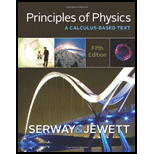
(a)
The magnitude of the torque.
(a)
Answer to Problem 28P
The magnitude of the torque is
Explanation of Solution
Write the formula for torque on a rotor.
Here,
Conclusion:
Substitute
The magnitude of the torque is
(b)
The peak power output.
(b)
Answer to Problem 28P
The peak power output is
Explanation of Solution
Write the formula for power on a motor.
Here,
Conclusion:
Substitute
The peak power output is
(c)
The amount of work performed.
(c)
Answer to Problem 28P
The amount of work performed is
Explanation of Solution
Write the formula for work in one half revolutions is,
Here,
Write the formula for potential energy.
Here,
Write the formula for torque on a rotor.
Here,
Write the formula for torque on a rotor.
Here,
Equate expression (III) and (IV) and substitute in (V)
Conclusion:
Substitute
Equate expression (III) and (IV) and substitute in (V),
Substitute
In one full revolution,
The amount of work performed is
(d)
The average power of the motor.
(d)
Answer to Problem 28P
The average power of the motor is
Explanation of Solution
Write the formula for power on a motor.
Here,
Conclusion:
The time for revolution is
Substitute
The average power of the motor is
Want to see more full solutions like this?
Chapter 22 Solutions
Bundle: Principles of Physics: A Calculus-Based Text, 5th + WebAssign Printed Access Card for Serway/Jewett's Principles of Physics: A Calculus-Based Text, 5th Edition, Multi-Term
- please solve everything in detailarrow_forward6). What is the magnitude of the potential difference across the 20-02 resistor? 10 Ω 11 V - -Imm 20 Ω 10 Ω 5.00 10 Ω a. 3.2 V b. 7.8 V C. 11 V d. 5.0 V e. 8.6 Varrow_forward2). How much energy is stored in the 50-μF capacitor when Va - V₁ = 22V? 25 µF b 25 µF 50 µFarrow_forward
- 9). A series RC circuit has a time constant of 1.0 s. The battery has a voltage of 50 V and the maximum current just after closing the switch is 500 mA. The capacitor is initially uncharged. What is the charge on the capacitor 2.0 s after the switch is closed? R 50 V a. 0.43 C b. 0 66 C c. 0.86 C d. 0.99 C Carrow_forward1). Determine the equivalent capacitance of the combination shown when C = 12 pF. +11/20 2C C Carrow_forward3). When a capacitor has a charge of magnitude 80 μC on each plate the potential difference across the plates is 16 V. How much energy is stored in this capacitor when the potential difference across its plates is 42 V? a. 1.0 mJ b. 4.4 mJ c. 3.2 mJ d. 1.4 mJ e. 1.7 mJarrow_forward
- 5). A conductor of radius r, length & and resistivity p has resistance R. It is melted down and formed into a new conductor, also cylindrical, with one fourth the length of the original conductor. The resistance of the new conductor is a. 1 R 161 b. 1 R C. R d. 4R e. 16Rarrow_forward8). Determine the magnitude and sense (direction) of the current in the 10-Q2 resistor when I = 1.8 A. 30 V L 50 V 10 Ω 20 Ω a. 1.6 A right to left b. 1.6 A left to right C. 1.2 A right to left d. 1.2 A left to right e. 1.8 A left to right R PGarrow_forward7). Determine the current in the 10-V emf. 5.0 0 w 10 V 5.0 0 15 V 5.0 Ω a. 2.3 A b. 2.7 A c. 1.3 A d. 0.30 A e. 2.5 Aarrow_forward
- 4). What is the resistance of a wire made of a material with a resistivity of 3.2 is 2.5 m and its diameter is 0.50 mm? a. 0.16 Ω b. 0.10 2 C. c. 1.28 Ω d. 0.41 2 e. 0.81 2 108 m if its lengtharrow_forwardA flat circular coil with 135 turns, a radius of 2.28 x 10-2 m, and a resistance of 0.618 is exposed to an external magnetic field that is directed perpendicular to the plane of the coil. The magnitude of the external magnetic field is changing at a rate of AB/At = 0.615 T/s, thereby inducing a current in the coil. Find the magnitude of the magnetic field at the center of the coil that is produced by the induced current. Numberarrow_forwardplease solve the question attachedarrow_forward
 Principles of Physics: A Calculus-Based TextPhysicsISBN:9781133104261Author:Raymond A. Serway, John W. JewettPublisher:Cengage Learning
Principles of Physics: A Calculus-Based TextPhysicsISBN:9781133104261Author:Raymond A. Serway, John W. JewettPublisher:Cengage Learning Physics for Scientists and Engineers: Foundations...PhysicsISBN:9781133939146Author:Katz, Debora M.Publisher:Cengage Learning
Physics for Scientists and Engineers: Foundations...PhysicsISBN:9781133939146Author:Katz, Debora M.Publisher:Cengage Learning Physics for Scientists and Engineers with Modern ...PhysicsISBN:9781337553292Author:Raymond A. Serway, John W. JewettPublisher:Cengage Learning
Physics for Scientists and Engineers with Modern ...PhysicsISBN:9781337553292Author:Raymond A. Serway, John W. JewettPublisher:Cengage Learning Physics for Scientists and EngineersPhysicsISBN:9781337553278Author:Raymond A. Serway, John W. JewettPublisher:Cengage Learning
Physics for Scientists and EngineersPhysicsISBN:9781337553278Author:Raymond A. Serway, John W. JewettPublisher:Cengage Learning
 Glencoe Physics: Principles and Problems, Student...PhysicsISBN:9780078807213Author:Paul W. ZitzewitzPublisher:Glencoe/McGraw-Hill
Glencoe Physics: Principles and Problems, Student...PhysicsISBN:9780078807213Author:Paul W. ZitzewitzPublisher:Glencoe/McGraw-Hill





